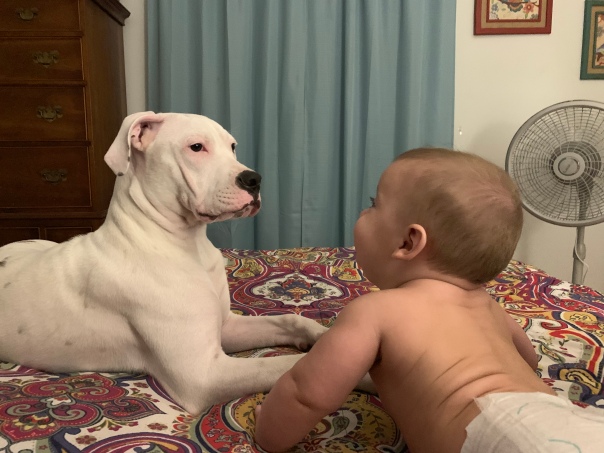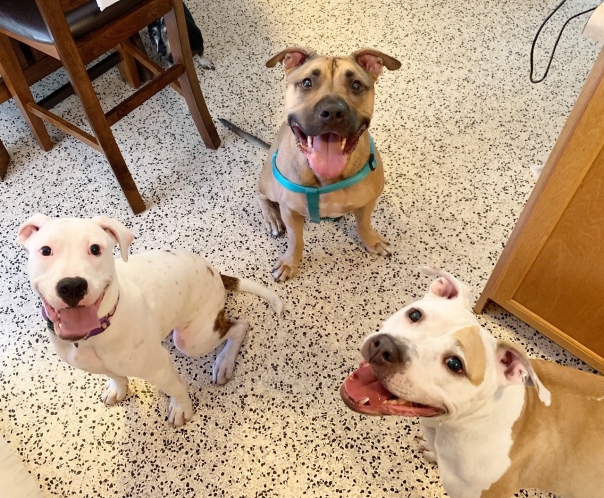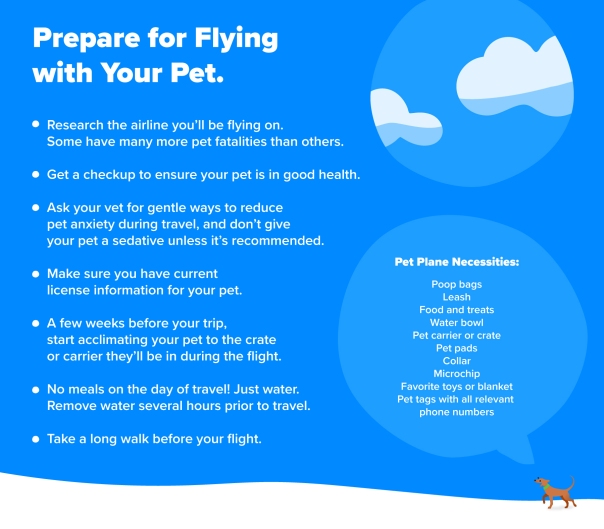
Four days after the birth of Camilla’s son, she was bored and breastfeeding. A friend of hers who worked for a pet rescue mentioned that a new litter of puppies had come in, and all had been adopted—all except one. This puppy was deaf.
Immediately, Camilla—who had previously owned a “daredevil” deaf cat, and currently had two rescue cats and a dog—was moved by the pup’s plight, but her husband wasn’t so sure. They already had a lot of animals, and Camilla would have to balance the new pet with her work in tech support and the new baby.
When three months had passed, and the lonesome pup still hadn’t been adopted, Camilla convinced her husband to make the two-hour drive to visit the dog in person. He fell in love, and Charlie came home with them.

Camilla has always been passionate about rescue animals. “I like the rejects,” she told us. Recently, we interviewed Camilla about Charlie’s training, what she wants people to know about adopting a deaf dog, and how Pawscout has helped with some of the unique challenges of caring for a deaf pet.
1. Deaf dog training may be easier than you think
The question most people have about adopting a deaf dog is, “How will I train them?” Camilla had similar concerns herself, but Charlie proved a pleasant surprise.
Charlie caught on quick to basic signs: sit, eat, stay, calm. At night, when hand signals aren’t visible, the family uses flashlights to get Charlie’s attention. He’s very attentive to his people, so most of the time Camilla wants him to look at her, Charlie already is.
“We really thought it was gonna be a much bigger challenge than it was.”

Charlie also takes a lot of cues from Vader, his dog brother. Vader, a three-year-old pit bull mix, is also a rescue; his owner abandoned him in an apartment. Charlie always wants to do whatever Vader’s doing, which is not only adorable, it’s helpful for a pet parent. When Camilla tells Vader to “get off the bed” and Vader follows the verbal command, Charlie will jump down after him!

It hasn’t been totally smooth sailing. Potty-training was a challenge. Since you can’t order a dog to poop (and believe us, we’ve tried here at Pawscout HQ), Charlie’s family had to be proactive. They took him out every hour or hour and a half, waited for him to do his business, and rewarded him each time with praise, pets, and treats. It took Charlie less than a month to stop having accidents.
2. Deaf dogs will quickly become a cherished part of your pack

Now nine months old, Charlie is part of the family. Sweet to everyone and gentle with the baby, he can typically be found hanging out with Vader (who is usually by Camilla’s feet). “He’s so easy to handle and so easy to love.”
Camilla reports that Charlie’s a chewer, but that he tries hard not to chew things he isn’t supposed to. And of course, he’s got a few of those fabulous dog quirks that fill our hooman hearts with glee: Since Charlie is so sensitive to light, he’s freaked out by shadows, and tends to follow his around while barking at it.
3. There are unique challenges to caring for deaf pets
Camilla told us that before she found Pawscout, she fretted about Charlie’s safety. “I was always afraid that he was gonna run away, because we have a fenced-in backyard, but he’s a tall dog.” Camilla’s fears demonstrate some of the issues that can arise when you lose track of a deaf pet. A deaf dog investigating a nearby garbage can won’t be able to respond when you call him, and may not be paying attention to hand signals. During the daytime, flashlights won’t look different enough from surrounding lighting conditions to grab his attention.
Enter Pawscout. Camilla uses Pawscout to receive instant notifications when Charlie tries to leave the yard, providing her with an estimate of his location that doesn’t rely on visual confirmation. She also talks to fellow pet owners on Pawscout’s built-in social feed.
4. You don’t have to raise a deaf dog alone

If there’s one thing Camilla wants people to take from her story, it’s that deaf pets are just like hearing ones. “People get weirded out,” Camilla told us, but she maintains that anyone who can care for a dog can care for a deaf dog.
“It’s the same as training another dog, same amount of effort. Instead of verbal commands, they’re gonna have to learn visual commands. It’s not hard, it’s just a challenge until you get used to it.”
But you don’t have to get used to it alone. Camilla participates in a number of online groups for deaf dogs (including the aptly named Reddit sub r/deafdogs), which provide a valuable network of deaf dog owners who can answer questions and give advice. She also recommends the book “A Deaf Dog Joins the Family,” which gave her a lot of information about what to expect and how to handle it.
If you’re wondering whether to adopt a deaf dog, we hope Camilla’s story will help you decide. In the meantime, download the Pawscout App and start building your own community of pet lovers.
Get the App














 If dogs’ noses are as amazing as science says, why do they get lost at all? It may surprise you, but a dog’s ability to smell can decrease significantly if they’re scared. This is something that happens to humans as well: When we’re in crisis, our hearing and vision can
If dogs’ noses are as amazing as science says, why do they get lost at all? It may surprise you, but a dog’s ability to smell can decrease significantly if they’re scared. This is something that happens to humans as well: When we’re in crisis, our hearing and vision can 





